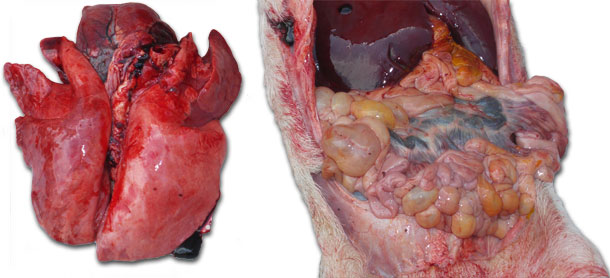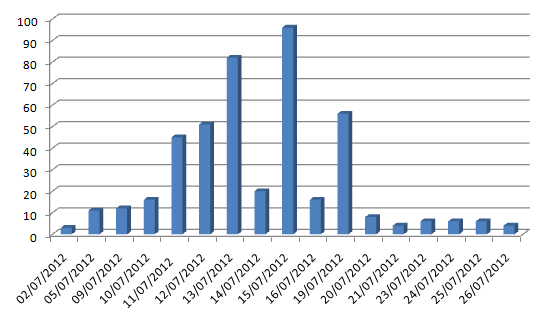Description of the farm
It is a site 2 in which we enter 21 day old piglets that come from a site 1 located some 500 km away. The site 2 is filled up with 2 batches of 1,000 weaned piglets with a seven day interval. This clinical case happened on June 21st and 28th 2012. The sanitary state of the site 1 is as follows: PRRS +, Mycoplasma Hyopneumoniae +, Circovirus +, App +, Hps +, Steptococcus Suis Type 2 +, Aujeszky -, Mange -. In the site 2 there in an all-in-all-out management.

The farm in question pertains to an integrated production system that has a great amount of anamnestic data relative to the pigs and their origin. The data tell that the pathogen that normally manifests is Strepococcus Suis Type 2. The strategic medication that is regularly carried out bears especially in mind this fact and the risk, always present, of an enteritis due to E. Coli. The piglets arrive regularly vaccinated against PCV2 and Mycoplasma hyopneumoniae. The farm is PRRS-positive.
The feeding scheme and the medication used is as follows:
1st week (1.5 kg/pig): Prestarter + 3,000 ppm ZnO and Amoxicillin in the drinking water
2nd-3rd week (6 kg/pig): Link feed + 600 ppm Amoxicillin and 180 ppm Colistin
4th-6th week: Starter + 3,000 ppm ZnO
7th-9th week: Starter without medication

Appearance of the case and first actions (days 0-7)
On July 3rd and 4th some piglets appeared with nervous system symptomatology. Knowing the origin of the animals, an injectable therapy with amoxicillin administered to the affected piglets was adopted.
During the visit carried out on July 6th, as necropsy was performed on two piglets: a slight enteritis was seen with an affection of the lymph nodes. Some animals were sent to the laboratory for a more precise diagnosis and, meanwhile, we used gentamicin in the drinking water.
During Sunday the 8th and Monday the 9th of July, the number of animals with a nervous system symptomatology increased a 20%: we proceeded to carry out a therapy with amoxicillin in the drinking water and we injected amoxicillin to all the pigs (2,000 animals, approximately). At that time, the number of dead piglets was 26 out of the 2,026 piglets that entered the farm (1.28%). As it can be seen in the calendar, on July 5th 14 piglets died, whilst between Sunday the 8th and Monday the 9th of July 12 more animals died. The nervous system symptomatology is characterized by some meningitis, opistothonus, dizziness and deep depression cases in a great number of animals.
The necropsy showed, in all the cases, a serious lung congestion and an enteritis with a variable seriousness with a more or less important affectation of the mesenteric lymph nodes.

Diagnoses and measures taken (day 8)
On June 10th in the morning, the symptomatology did not show signs of improvement, and there were even new pigs with the same symptoms. Lastly, the diagnosis laboratory informed, via the telephone, that haemolytic E. coli was isolated and that it had an antibiogram that offered very few solutions.
| Sample 1 | INTESTINE | Identification | ||||
| Parameter/method | Result | Unit of measurement | Uncertainty | Limit | Start | End |
| Gastrointestinal pathogens | Haemolytic Escherichia coli | Jul 6th | Jul 7th | |||
| Microbiological: MI MD 12 rev. 0 of Dec 9th 2004 | ||||||
| Antibiogram | See appendix | Jul 9th | Jul 11th | |||
| Kirby-Bauer: MI MD 08 rev. 0 of Nov 26th 2004 | ||||||
| Sample 2 | INTESTINE | Identification | ||||
| Parameter/method | Result | Unit of measurement | Uncertainty | Limit | Start | End |
| Gastrointestinal pathogens | Haemolytic Escherichia coli | Jul 6th | Jul 11th | |||
|
Microbiological: MI MD 12 rev. 0 of Dec 9th 2004  |
||||||
| Sample 3 | HEAD | Identification | ||||
| Parameter/method | Result | Unit of measurement | Uncertainty | Limit | Start | End |
| Streptococcus suis | Negative | Jul 6th | Jul 11th | |||
| Microbiological: MI MD 06 rev. 0 of Nov 15th 2004 | ||||||
| Sample 4 | HEAD | Identification | ||||
| Parameter/method | Result | Unit of measurement | Uncertainty | Limit | Start | End |
| Streptococcus suis | Negative | Jul 6th | Jul 11th | |||
| Microbiological: MI MD 06 rev. 0 of Nov 15th 2004 | ||||||
ATTACHED ANTIBIOGRAMMaterial: swine intestine
|
|||||||||||||||
After the laboratory report we injected all the piglets with Enrofloxacin with a new formulation that guarantees a 48 hour coverage plus a rehydrating solution in the case of the more severely affected pigs. On that same day, we sent several animals more to another laboratory more specialized than the first one.
At the same time, given the limited information of the antibiogram, we decided to administer a product based in the oxolinic acid in the drinking water that, according to the experience of the veterinarian had given good results in similar cases. At the same time, we also gave a compound feed with a high fibre content and medicated with 3,000 ppm of ZnO.
Evolution of the case, new measures (days 9 - 14)
During the two following days the mortality went on in the already affected pigs and some new cases appeared. The total losses already exceeded a 10% and the majority of the animals ate very little food and the water consumption was scarce. It was decided to withdraw the medication and we administered a rehydrating/detoxifying product in the drinking water based on mineral salts, sugars, amino acids and vitamins in order to "feed" the animals and, especially, to reinstate the virtuous circle > water consumption > feed consumption > water consumption.
The water consumption returned to normal, the compound feed consumption started to increase and on Monday July 16th a group of animals started to show signs of returning to normality: mortality, nevertheless, reached more than a 15%. The pigs that were affected and severely weakened almost always died within 48-72 hours. Samples and entrails of the animals were taken and they were sent to the diagnosis laboratory.
Confirmation of the laboratory results
The laboratory results in relation to the sending of samples on June 10th shows, as in the first case, enteritis, lymphadenitis and lung congestion. Streptococcus suis was isolated from the brain of a pig and from the endocardium of another one.
|
Material sent: LIVE ANIMAL/CARCASS Species: SWINE RESULTS OF THE TESTS1st Test: Anatomopathological examination of medium/small-sized animals 2nd Test: Bacteriological exam 3rd Test: PRRS: etiologic agent 4th Test: Aujeszky's disease: etiologic agent 5th Test: Encephalomyocarditis cardiovirus: etiologic agent 6th Test: Antibiogram 7th Test: Bacteriological exam The acronyms MP or NK identify an `Internal test method`. *** END OF THE REPORT *** |
On the following days, from the results related with the samples sent to the laboratory on July 16th, emerges the presence of of several E. Coli strains, haemolytic or not. The genotypification of these strains shows the presence of the genes Stb and LT (although diarrhoea has never been a predominant symptom), and specially the genes VT2.
|
Material sent: LIVE ANIMAL/CARCASS/ pigs of approximately 40 days old RESULTS OF THE TESTS1st Test: Anatomopathological exam of big sized animals 2nd Test: Bacteriological exam 3rd Test: Genotypification of enterotoxigenic E.coli (ETEC) 4th Test: Genotypification of enterotoxigenic E.coli (ETEC) 5th Test: Verotoxins codifying gene/genes (VTEC) Escherichia coli 6th Test: Antibiogram 7th Test: Antibiogram
SPECIFICATIONS OF THE TESTTest: Genotypification technique of enterotoxigenic E.coli (ETEC): PCR Multiplex Sample Method: Not codified Test: Escherichia coli verotoxin codifying genes (VTEC) Technique: PCR RealTime Test method: MP 09/109 rev. 1 The acronyms MP or NK identify an `Internal test method`. *** END OF THE REPORT *** |
Solution and conclusions
The mortality rate starts to diminish significantly, but the number of piglets that cannot get back to a productive life is very high: On July 19th euthanasia was performed on these animals. On July 27th the total number of dead pigs was 442 with respect to the 2,025 that entered the farm (21.83%).

From the moment in which the piglets are part of an integrated production system, the main concern was the one relative to the groups of piglets weaned later from the same site 1: for the moment nothing abnormal is seen.
So, we follow on with the eternal question that does not find a convincing answer: Where did an E. Coli as a pathogen come from?; and the next challenge will be to evaluate what is going to happen with the same pigs from the same source in the same site 2.
Without a doubt, we have seen what a severe enterotoxaemia due to E. Coli could cause: severely depressed animals that could not get up to eat nor drink. Under this situation, the antibiotic administered in the water or the food does not arrive to its destination. The rehydration helped the animals to stand up, probably due to the sugared water, that encouraged them to drink. If they start to drink and eat, then the antibiotic achieves its effect.





